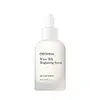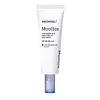What's inside
What's inside
 Key Ingredients
Key Ingredients

 Benefits
Benefits

 Concerns
Concerns

 Ingredients Side-by-side
Ingredients Side-by-side

Milk Protein
Skin ConditioningWater
Skin ConditioningBetula Platyphylla Japonica Juice
Skin ConditioningChamaecyparis Obtusa Water
MaskingDiphenylsiloxy Phenyl Trimethicone
Skin ConditioningNiacinamide
SmoothingDipropylene Glycol
HumectantPentaerythrityl Tetraethylhexanoate
EmollientButylene Glycol
HumectantGlycerin
HumectantPentylene Glycol
Skin Conditioning1,2-Hexanediol
Skin ConditioningHamamelis Virginiana Water
AstringentCentella Asiatica Extract
CleansingCaprylic/Capric Triglyceride
MaskingGlyceryl Caprylate
EmollientHydrogenated Lecithin
EmulsifyingCeramide NP
Skin ConditioningSodium PCA
HumectantSodium Stearoyl Glutamate
CleansingEthylhexylglycerin
Skin ConditioningSorbitan Isostearate
EmulsifyingPanthenol
Skin ConditioningColostrum
Skin ConditioningArbutin
AntioxidantBisabolol
MaskingHydroxyethyl Acrylate/Sodium Acryloyldimethyl Taurate Copolymer
Emulsion StabilisingDimethicone
EmollientTocopherol
AntioxidantGlutathione
Carbomer
Emulsion StabilisingBehenyl Alcohol
EmollientXanthan Gum
EmulsifyingTranexamic Acid
AstringentTromethamine
BufferingChondrus Crispus Extract
Skin ConditioningSaccharum Officinarum Extract
MoisturisingPortulaca Oleracea Extract
Skin ConditioningMilk Protein, Water, Betula Platyphylla Japonica Juice, Chamaecyparis Obtusa Water, Diphenylsiloxy Phenyl Trimethicone, Niacinamide, Dipropylene Glycol, Pentaerythrityl Tetraethylhexanoate, Butylene Glycol, Glycerin, Pentylene Glycol, 1,2-Hexanediol, Hamamelis Virginiana Water, Centella Asiatica Extract, Caprylic/Capric Triglyceride, Glyceryl Caprylate, Hydrogenated Lecithin, Ceramide NP, Sodium PCA, Sodium Stearoyl Glutamate, Ethylhexylglycerin, Sorbitan Isostearate, Panthenol, Colostrum, Arbutin, Bisabolol, Hydroxyethyl Acrylate/Sodium Acryloyldimethyl Taurate Copolymer, Dimethicone, Tocopherol, Glutathione, Carbomer, Behenyl Alcohol, Xanthan Gum, Tranexamic Acid, Tromethamine, Chondrus Crispus Extract, Saccharum Officinarum Extract, Portulaca Oleracea Extract
Water
Skin ConditioningZinc Oxide
Cosmetic ColorantButyloctyl Salicylate
Skin ConditioningPropanediol
SolventPropylheptyl Caprylate
EmollientCoco-Caprylate/Caprate
EmollientCyclohexasiloxane
EmollientIsododecane
EmollientTriethylhexanoin
MaskingMethyl Trimethicone
Skin ConditioningCaprylyl Methicone
Skin ConditioningNiacinamide
SmoothingSodium Hyaluronate
HumectantXylitol
HumectantCentella Asiatica Extract
CleansingCentella Asiatica Leaf Extract
Skin ConditioningCentella Asiatica Root Extract
Skin ConditioningMoringa Oleifera Seed Oil
EmollientEnantia Chlorantha Bark Extract
Skin ConditioningSoluble Collagen
HumectantVitis Vinifera Fruit Extract
Skin ConditioningEuterpe Oleracea Fruit Extract
Hydrolyzed Hyaluronic Acid
HumectantHyaluronic Acid
HumectantAnemarrhena Asphodeloides Root Extract
Skin ConditioningLauryl Polyglyceryl-3 Polydimethylsiloxyethyl Dimethicone
Skin ConditioningMagnesium Sulfate
Methyl Methacrylate Crosspolymer
Triethoxycaprylylsilane
Lauryl Dimethicone/Polyglycerin-3 Crosspolymer
CleansingDisteardimonium Hectorite
Stabilising1,2-Hexanediol
Skin ConditioningPolyglyceryl-2 Dipolyhydroxystearate
Skin ConditioningCaprylyl Glycol
EmollientGlyceryl Caprylate
EmollientAdenosine
Skin ConditioningDipropylene Glycol
HumectantButylene Glycol
HumectantTocopherol
AntioxidantSodium Citrate
BufferingEthylhexylglycerin
Skin ConditioningGlycerin
HumectantHydrolyzed Sodium Hyaluronate
Skin ConditioningAllantoin
Skin ConditioningEctoin
Skin ConditioningPolyglutamic Acid
Skin ConditioningHydrogenated Polyisobutene
EmollientGlyceryl Glucoside
HumectantCeramide NP
Skin ConditioningPhytosphingosine
Skin ConditioningGlucose
HumectantGlycine
BufferingHydrogenated Lecithin
EmulsifyingArginine
MaskingGlutamic Acid
HumectantDimethylsilanol Hyaluronate
HumectantCaprylhydroxamic Acid
Potassium Hyaluronate
Skin ConditioningHydroxypropyltrimonium Hyaluronate
Sodium Hyaluronate Crosspolymer
HumectantSodium Hyaluronate Dimethylsilanol
HumectantSodium Acetylated Hyaluronate
HumectantOleanolic Acid
Skin ConditioningMadecassoside
AntioxidantAsiaticoside
AntioxidantAsiatic Acid
Skin ConditioningMadecassic Acid
Skin ConditioningParfum
MaskingUltramarines
Water, Zinc Oxide, Butyloctyl Salicylate, Propanediol, Propylheptyl Caprylate, Coco-Caprylate/Caprate, Cyclohexasiloxane, Isododecane, Triethylhexanoin, Methyl Trimethicone, Caprylyl Methicone, Niacinamide, Sodium Hyaluronate, Xylitol, Centella Asiatica Extract, Centella Asiatica Leaf Extract, Centella Asiatica Root Extract, Moringa Oleifera Seed Oil, Enantia Chlorantha Bark Extract, Soluble Collagen, Vitis Vinifera Fruit Extract, Euterpe Oleracea Fruit Extract, Hydrolyzed Hyaluronic Acid, Hyaluronic Acid, Anemarrhena Asphodeloides Root Extract, Lauryl Polyglyceryl-3 Polydimethylsiloxyethyl Dimethicone, Magnesium Sulfate, Methyl Methacrylate Crosspolymer, Triethoxycaprylylsilane, Lauryl Dimethicone/Polyglycerin-3 Crosspolymer, Disteardimonium Hectorite, 1,2-Hexanediol, Polyglyceryl-2 Dipolyhydroxystearate, Caprylyl Glycol, Glyceryl Caprylate, Adenosine, Dipropylene Glycol, Butylene Glycol, Tocopherol, Sodium Citrate, Ethylhexylglycerin, Glycerin, Hydrolyzed Sodium Hyaluronate, Allantoin, Ectoin, Polyglutamic Acid, Hydrogenated Polyisobutene, Glyceryl Glucoside, Ceramide NP, Phytosphingosine, Glucose, Glycine, Hydrogenated Lecithin, Arginine, Glutamic Acid, Dimethylsilanol Hyaluronate, Caprylhydroxamic Acid, Potassium Hyaluronate, Hydroxypropyltrimonium Hyaluronate, Sodium Hyaluronate Crosspolymer, Sodium Hyaluronate Dimethylsilanol, Sodium Acetylated Hyaluronate, Oleanolic Acid, Madecassoside, Asiaticoside, Asiatic Acid, Madecassic Acid, Parfum, Ultramarines
Ingredients Explained
These ingredients are found in both products.
Ingredients higher up in an ingredient list are typically present in a larger amount.
1,2-Hexanediol is a synthetic liquid and another multi-functional powerhouse.
It is a:
- Humectant, drawing moisture into the skin
- Emollient, helping to soften skin
- Solvent, dispersing and stabilizing formulas
- Preservative booster, enhancing the antimicrobial activity of other preservatives
Butylene Glycol (or BG) is used within cosmetic products for a few different reasons:
Overall, Butylene Glycol is a safe and well-rounded ingredient that works well with other ingredients.
Though this ingredient works well with most skin types, some people with sensitive skin may experience a reaction such as allergic rashes, closed comedones, or itchiness.
Learn more about Butylene GlycolCentella Asiatica Extract (Centella) is derived from an herb native to Southeast Asia. It is famous for its anti-inflammatory and soothing properties.
Centella is rich in antioxidants and amino acids, such as Madecassic Acid and Asiaticoside.
Studies show the compounds in centella help with:
The combination of all these properties makes centella effective at soothing, hydrating, and protecting the skin.
Other great components of centella include Vitamin A, vitamin C, several B vitamins, and Asiatic Acid.
Fun fact: Centella has been used as a medicine and in food for many centuries. As a medicine, it is used to treat burns, scratches, and wounds.
Learn more about Centella Asiatica ExtractCeramide NP is a type of ceramide and formally known as ceramide 3.
Ceramides are intercellular lipids naturally found in our skin that bonds dead skin cells together to create a barrier. They are known for their ability to hold water and thus are a great ingredient for dry skin.
Ceramides are an important building block for our skin barrier. A stronger barrier helps the skin look more firm and hydrated. By bolstering the skin ceramides act as a barrier against irritating ingredients. This can help with inflammation as well.
If you would like to eat ceramides, sweet potatoes contain a small amount.
Read more about other common types of ceramides here:
Ceramide AP
Ceramide EOP
Dipropylene Glycol is a synthetically created humectant, stabilizer, and solvent.
This ingredient helps:
Dipropylene glycol is technically an alcohol, but it belongs to the glycol family (often considered part of the ‘good’ alcohols). This means it is hydrating and gentle on skin unlike drying solvent alcohols like denatured alcohol.
As a masking agent, Dipropylene Glycol can be used to cover the smell of other ingredients. However, it does not have a scent.
Studies show Dipropylene Glycol is considered safe to use in skincare.
Learn more about Dipropylene GlycolEthylhexylglycerin (we can't pronounce this either) is commonly used as a preservative and skin softener. It is derived from glyceryl.
You might see Ethylhexylglycerin often paired with other preservatives such as phenoxyethanol. Ethylhexylglycerin has been found to increase the effectiveness of these other preservatives.
Glycerin is already naturally found in your skin. It helps moisturize and protect your skin.
A study from 2016 found glycerin to be more effective as a humectant than AHAs and hyaluronic acid.
As a humectant, it helps the skin stay hydrated by pulling moisture to your skin. The low molecular weight of glycerin allows it to pull moisture into the deeper layers of your skin.
Hydrated skin improves your skin barrier; Your skin barrier helps protect against irritants and bacteria.
Glycerin has also been found to have antimicrobial and antiviral properties. Due to these properties, glycerin is often used in wound and burn treatments.
In cosmetics, glycerin is usually derived from plants such as soybean or palm. However, it can also be sourced from animals, such as tallow or animal fat.
This ingredient is organic, colorless, odorless, and non-toxic.
Glycerin is the name for this ingredient in American English. British English uses Glycerol/Glycerine.
Learn more about GlycerinGlyceryl Caprylate comes from glycerin and caprylic acid, a fatty acid from coconut. It has emollient and emulsifier properties.
As an emollient, it helps hydrate your skin. Emollients work by creating a barrier on your skin to trap moisture in, helping to keep your skin soft and smooth.
On the other hand, emulsifiers prevent ingredients (such as oil and water) from separating.
Learn more about Glyceryl CaprylateHydrogenated Lecithin is created from the hydrogenation of lecithin (a group of phospholipids). Hydrogenation is a chemical reaction between hydrogen and another element.
This ingredient is an emollient and emulsifier. As an emollient, it helps soften skin by trapping moisture within. As an emulsifier, it prevents oil and water ingredients from separating.
Niacinamide is a multitasking form of vitamin B3 that strengthens the skin barrier, reduces pores and dark spots, regulates oil, and improves signs of aging.
And the best part? It's gentle and well-tolerated by most skin types, including sensitive and reactive skin.
You might have heard of "niacin flush", or the reddening of skin that causes itchiness. Niacinamide has not been found to cause this.
In very rare cases, some individuals may not be able to tolerate niacinamide at all or experience an allergic reaction to it.
If you are experiencing flaking, irritation, and dryness with this ingredient, be sure to double check all your products as this ingredient can be found in all categories of skincare.
When incorporating niacinamide into your routine, look out for concentration amounts. Typically, 5% niacinamide provides benefits such as fading dark spots. However, if you have sensitive skin, it is better to begin with a smaller concentration.
When you apply niacinamide to your skin, your body converts it into nicotinamide adenine dinucleotide (NAD). NAD is an essential coenzyme that is already found in your cells as "fuel" and powers countless biological processes.
In your skin, NAD helps repair cell damage, produce new healthy cells, support collagen production, strengthen the skin barrier, and fight environmental stressors (like UV and pollution).
Our natural NAD levels start to decline with age, leading to slower skin repair, visible aging, and a weaker skin barrier. By providing your skin niacinamide, you're recharging your skin's NAD levels. This leads to stronger, healthier, and younger looking skin.
Another name for vitamin B3 is nicotinamide. This vitamin is water-soluble and our bodies don't store it. We obtain Vitamin B3 from either food or skincare. Meat, fish, wheat, yeast, and leafy greens contain vitamin B3.
The type of niacinamide used in skincare is synthetically created.
Learn more about NiacinamideTocopherol (also known as Vitamin E) is a common antioxidant used to help protect the skin from free-radicals and strengthen the skin barrier. It's also fat soluble - this means our skin is great at absorbing it.
Vitamin E also helps keep your natural skin lipids healthy. Your lipid skin barrier naturally consists of lipids, ceramides, and fatty acids. Vitamin E offers extra protection for your skin’s lipid barrier, keeping your skin healthy and nourished.
Another benefit is a bit of UV protection. Vitamin E helps reduce the damage caused by UVB rays. (It should not replace your sunscreen). Combining it with Vitamin C can decrease sunburned cells and hyperpigmentation after UV exposure.
You might have noticed Vitamin E + C often paired together. This is because it is great at stabilizing Vitamin C. Using the two together helps increase the effectiveness of both ingredients.
There are often claims that Vitamin E can reduce/prevent scarring, but these claims haven't been confirmed by scientific research.
Learn more about TocopherolWater. It's the most common cosmetic ingredient of all. You'll usually see it at the top of ingredient lists, meaning that it makes up the largest part of the product.
So why is it so popular? Water most often acts as a solvent - this means that it helps dissolve other ingredients into the formulation.
You'll also recognize water as that liquid we all need to stay alive. If you see this, drink a glass of water. Stay hydrated!
Learn more about Water